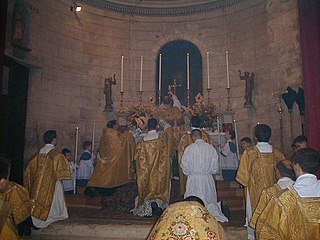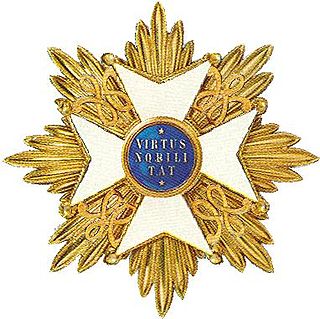
The square academic cap, graduate cap, cap, mortarboard or Oxford cap, is an item of academic dress consisting of a horizontal square board fixed upon a skull-cap, with a tassel attached to the centre. In the UK and the US, it is commonly referred to informally in conjunction with an academic gown as a "cap and gown". It is also sometimes termed a square, trencher, or corner-cap. The adjective academical is also used.

Academic dress is a traditional form of clothing for academic settings, mainly tertiary education, worn mainly by those who have obtained a university degree, or hold a status that entitles them to assume them. It is also known as academical dress, academicals, and, in the United States, as academic regalia.

The University of Oxford has a long tradition of academic dress, which continues to the present day.

Vestments are liturgical garments and articles associated primarily with the Christian religion, especially by Eastern Churches, Catholics, Anglicans, and Lutherans. Many other groups also make use of liturgical garments; this was a point of controversy in the Protestant Reformation and sometimes since, in particular during the ritualist controversies in England in the 19th century.

A cantus, is an activity organised by Belgian, Dutch, French, Baltic, and fraternities. A cantus mainly involves singing traditional songs and drinking beer. It is governed by strict traditional rules. The use of this dates back a few centuries and was inspired by German student organisations; however some of the songs that are sung date back to the Middle Ages. Cantus probably shares same roots with commercium, sitsit and tableround.

The University of Cambridge has a long tradition of academic dress, which it traditionally refers to as academical dress. Almost every degree which is awarded by the university has its own distinct gown in addition to having its own hood. Undergraduates wear college gowns which have subtle differences enabling the wearer's college to be determined. Academic dress is worn quite often in Cambridge on formal, and sometimes informal, occasions, and there are a number of rules and customs governing when and how it is worn. Black gowns (undress) are worn at less formal events, while on special days full academical dress is worn, consisting of gown, hood and headdress with Doctors in festal dress. The university's officials also have ancient forms of academic dress, unique to the university.

A mobcap is a round, gathered or pleated cloth bonnet consisting of a caul to cover the hair, a frilled or ruffled brim, and (often) a ribbon band, worn by married women in the 18th and early 19th centuries, when it was called a "bonnet". These caps were always gathered to a flat, often curved, brim. The caul had a flat bottom and curved top. The bottom was typically gathered to fit the back neck with a drawstring, while the curved sides and top were tightly gathered and stitched to the brim, which typically had some curves, too. Originally an informal style, the bonnet became a high-fashion item as part of the adoption of simple "country" clothing in the later 18th century. It was an indoor fashion, and was worn under a hat for outdoor wear.

Fashion in the period 1550–1600 in Western European clothing was characterized by increased opulence. Contrasting fabrics, slashes, embroidery, applied trims, and other forms of surface ornamentation remained prominent. The wide silhouette, conical for women with breadth at the hips and broadly square for men with width at the shoulders had reached its peak in the 1530s, and by mid-century a tall, narrow line with a V-lined waist was back in fashion. Sleeves and women's skirts then began to widen again, with emphasis at the shoulder that would continue into the next century. The characteristic garment of the period was the ruff, which began as a modest ruffle attached to the neckband of a shirt or smock and grew into a separate garment of fine linen, trimmed with lace, cutwork or embroidery, and shaped into crisp, precise folds with starch and heated irons.

Fashion in the years 1750–1775 in European countries and the colonial Americas was characterised by greater abundance, elaboration and intricacy in clothing designs, loved by the Rococo artistic trends of the period. The French and English styles of fashion were very different from one another. French style was defined by elaborate court dress, colourful and rich in decoration, worn by such iconic fashion figures as Marie Antoinette.
Academic dress at the University of St Andrews involves students wearing distinctive academic gowns whilst studying at the University of St Andrews. Undergraduate gowns in Scotland were once common at all the ancient universities of Scotland, with each having its own distinctive style. St Andrews undergraduates wear either a scarlet gown if they are part of the United College and studying in the Faculties of Arts, Medicine and Science, or a black gown if they are part of St Mary's College and studying in the Faculty of Divinity.

Fashion in 15th-century Europe was characterized by a series of extremes and extravagances, from the voluminous robes called houppelandes with their sweeping floor-length sleeves to the revealing doublets and hose of Renaissance Italy. Hats, hoods, and other headdresses assumed increasing importance, and were draped, jewelled, and feathered.

In the Dutch honours system, most orders are the responsibility of ministers of the Netherlands Government. The house orders, however, are awarded at the discretion of the Dutch monarch alone.

Jean-Baptiste Bethune {April 25, 1821 - June 18, 1894) was a Belgian architect, artisan and designer who played a pivotal role in the Belgian and Catholic Gothic Revival movement. He was called by some the "Pugin of Belgium", with reference to the influence on Bethune of the English Gothic Revival architect and designer, Augustus Pugin.
Academic dress at the University of Glasgow is worn at ceremonial events throughout the academic year. This primarily entails graduations, but includes Commemoration Day, church services, and the installation of Chancellors and Rectors of the University. The academic dress of all members of the University of Glasgow, including students, is regulated by the University Regulations. It shares many similarities with the other ancient universities of Scotland, most conspicuously that, unlike in the rest of the United Kingdom, headwear is only very rarely worn. Academic dress has been worn in the University of Glasgow since medieval times

The academic dress of the United Kingdom and Ireland has a long history and has influenced the academic dress of America and beyond. The academic square cap was invented in the UK as well as the hood which developed from the lay dress of the medieval period.

Fashion in the twenty years between 1775 and 1795 in Western culture became simpler and less elaborate. These changes were a result of emerging modern ideals of selfhood, the declining fashionability of highly elaborate Rococo styles, and the widespread embrace of the rationalistic or "classical" ideals of Enlightenment philosophes.

The academic dress of McGill University describes the caps, gowns and hoods which are prescribed by the university for its degree candidates/holders. Until the mid-20th century, McGill also prescribed academic dress for its matriculating or enrolled students as well as its faculty. Founded in 1821, McGill University is consistently ranked as one of Canada's preeminent universities, and among the top 20 universities in the world.

William Henry James Weale was a British art historian who lived and worked most of his life in Bruges and was one of the first to research the Early Netherlandish painting extensively. He was also a pioneer in the study of early bookbinding, and a staunch promoter of Gothic Revival architecture.

A royal christening gown is an item of baptismal clothing used by a royal family at family christenings. Among those presently using such a gown are the royal families of the United Kingdom, Denmark, the Netherlands, Norway, Spain, and Sweden. In most of these families, the tradition goes back over a century: as of 2019, the Swedish gown has been in service for 113 years, the Dutch gown for 139 years, and the Danish gown for 149 years; the current British gown has been in use since 2008. The Spanish gown has been in use for 81 years.
The academic dress of the University of Tasmania describes the formal attire of robes, gowns and hoods prescribed by the ordinance of academic dress of the University of Tasmania. The ordinance prescribes the Oxford style for the gowns and hoods for both undergraduate and postgraduate academic dress.



















